Lake and Land Breezes at a Mediterranean Artificial Lake: Observations in Alqueva Reservoir, Portugal
Abstract
1. Introduction
2. Data and Methodology
2.1. Site Description
2.2. Meteorological Stations at Alqueva Reservoir
- Thermo-Hygrometer at 2 m height (air temperature and relative humidity);
- 2-axis Ultrasonic Anemometer at 3 m height (wind speed and direction);
- Udometer (precipitation);
- Albedometer (downwelling and upwelling solar irradiance).
- Temperature Array of 14 thermistors (water temperatures sensors measured at 0.05, 0.25, 0.50, 1, 2, 4, 6, 8, 10, 12, 15, 20, 30, and 60 m depth);
- Integrated open-path analyzer and sonic anemometer (IRGASON) measuring the following parameters at 1.75 m from the water surface:
- ◦
- Air temperature;
- ◦
- Atmospheric pressure;
- ◦
- Wind speed and direction;
- ◦
- Water vapor concentration;
- ◦
- Carbon dioxide concentration.
- Albedometer (downwelling and upwelling solar irradiance);
2.3. Criteria for Breeze Detection between Onshore Stations at Opposite Sides
- For lake breeze scenario, the wind direction on the north shore (Barbosa) had to be greater than 45° and lower than 225° (from the lower half—lake side) and at the same time on the south shore (Cid Almeida), the wind should have the opposite direction (from the upper half); we also tested other plans, namely the 240°–60° plane, which is roughly parallel to the southern shoreline of the reservoir, and the results showed only slight differences of the order of 1–3% of total breeze hours. We decided to apply the 225°–45° plane, which is closest to the reservoir’s symmetry axis on this section.
- In case of land breeze circulation, the wind field should be reverse with respect to that of lake breeze case and wind should blow from the upper half (land side) in Barbosa and from the lower half in Cid Almeida;
- Additionally, for both cases the wind direction difference between the two onshore stations has to be greater than 90° to avoid close directions even in opposite quadrants, that do not represent breeze circulations;
- For both scenarios, daily precipitation events greater than 0.5 mm were discarded, following Román-Cascón et al. [33];
- Finally, in order to be considered a breeze event at a particular hour, the conditions should be fulfilled during at least twenty minutes.
3. Results and Discussion
3.1. Thermal Gradient between Lake and Surroundings
3.2. Lake Breeze
Stronger Lake Breeze Cases
3.3. Land Breeze
Stronger Land Breeze Cases
4. Conclusions
Supplementary Materials
Author Contributions
Funding
Data Availability Statement
Acknowledgments
Conflicts of Interest
References
- Lemmin, U.; D’Adamo, N. Summertime Winds and Direct Cyclonic Circulation: Observations from Lake Geneva. Ann. Geophys. 1996, 14, 1207–1220. [Google Scholar] [CrossRef]
- Gerken, T.; Biermann, T.; Babel, W.; Herzog, M.; Ma, Y.; Foken, T.; Graf, H.-F. A Modelling Investigation into Lake-Breeze Development and Convection Triggering in the Nam Co Lake Basin, Tibetan Plateau. Theor. Appl. Climatol. 2014, 117, 149–167. [Google Scholar] [CrossRef]
- Crosman, E.T.; Horel, J.D. Sea and Lake Breezes: A Review of Numerical Studies. Bound. Layer Meteorol. 2010, 137, 1–29. [Google Scholar] [CrossRef]
- Wang, Y.; Gao, Y.; Qin, H.; Huang, J.; Liu, C.; Hu, C.; Wang, W.; Liu, S.; Lee, X. Spatiotemporal Characteristics of Lake Breezes over Lake Taihu, China. J. Appl. Meteorol. Climatol. 2017, 58, 2053–2065. [Google Scholar] [CrossRef]
- Balsamo, G.; Salgado, R.; Dutra, E.; Boussetta, S.; Stockdale, T.; Potes, M. On the Contribution of Lakes in Predicting Near-Surface Temperature in a Global Weather Forecasting Model. Tellus A Dyn. Meteorol. Oceanogr. 2012, 64, 15829. [Google Scholar] [CrossRef]
- Kheyrollah Pour, H.; Duguay, C.; Martynov, A.; Brown, L.C. Simulation of Surface Temperature and Ice Cover of Large Northern Lakes with 1-D Models: A Comparison with MODIS Satellite Data and in Situ Measurements. Tellus A Dyn. Meteorol. Oceanogr. 2012, 64, 17614. [Google Scholar] [CrossRef]
- Zhang, X.; Huang, J.; Li, G.; Wang, Y.; Liu, C.; Zhao, K.; Tao, X.; Hu, X.-M.; Lee, X. Improving Lake-Breeze Simulation with WRF Nested LES and Lake Model over a Large Shallow Lake. J. Appl. Meteorol. Climatol. 2019, 58, 1689. [Google Scholar] [CrossRef]
- Keen, C.; Lyons, W. Lake/Land Breeze Circulations on the Western Shore of Lake Michigan. J. Appl. Meteorol. Climatol. 1978, 17, 1843. [Google Scholar] [CrossRef]
- Schoenberger, L.M. Doppler Radar Observation of a Land-Breeze Cold Front. Mon. Weather Rev. 1984, 112, 2455–2464. [Google Scholar] [CrossRef][Green Version]
- Stull, R.B. An Introduction to Boundary Layer Meteorology, 2nd ed.; Kluwer Academic Publishers: Dordrecht, The Netherlands, 1988; pp. 587–595. [Google Scholar]
- Mariani, Z.; Dehghan, A.; Joe, P.; Sills, D. Observations of Lake-Breeze Events during the Toronto 20155 Pan-American Games. Bound. Layer Meteorol. 2018, 166, 113–135. [Google Scholar] [CrossRef]
- Sills, D.; Brook, J.; Levy, I.; Makar, P.; Zhang, J.; Taylor, P. Lake Breezes in the Southern Great Lakes Region and Their Influence during BAQS-Met 2007. Atmos. Chem. Phys. 2011, 11, 7955–7973. [Google Scholar] [CrossRef]
- Miranda, P.B. Meteorologia e Ambiente; Universidade Aberta: Lisbon, Portugal, 2001; Volume 219. [Google Scholar]
- Nogueira, M. Estudo de Brisas e Depressões Térmicas: Aplicação à Península Ibérica. Master’s Thesis, University of Lisbon, Lisbon, Portugal, 2009. [Google Scholar]
- Assunção, S. Impacto da Introdução da Albufeira de Alqueva no Modelo de Previsão AROME. Master’s Thesis, University of Évora, Évora, Portugal, 2017. [Google Scholar]
- Iakunin, M.; Salgado, R.; Potes, M. Breeze Effects at a Large Artificial Lake: Summer Case Study. Hydrol. Earth Syst. Sci. 2018, 22, 5191–5210. [Google Scholar] [CrossRef]
- Giovannini, L.; Laiti, L.; Zardi, D.; Franceschi, M. Climatological Characteristics of the Ora del Garda Wind in the Alps. Int. J. Climatol. 2015, 35, 4103–4115. [Google Scholar] [CrossRef]
- Le Moigne, P.; Legain, D.; Lagarde, F.; Potes, M.; Tzanos, D.; Moulin, E.; Barrié, J.; Salgado, R.; Messiaen, G.; Fiandrino, A.; et al. Evaluation of the Lake Model FLake over a Coastal Lagoon during the THAUMEX Field Campaign. Tellus A Dyn. Meteorol. Oceanogr. 2013, 65, 20951. [Google Scholar] [CrossRef][Green Version]
- Bouin, M.-N.; Caniaux, G.; Traullé, O.; Legain, D.; Le Moigne, P. Long-Term Heat Exchanges over a Mediterranean Lagoon. J. Geophys. Res. Atmos. 2012, 117, D23104. [Google Scholar] [CrossRef]
- Crosman, E.T.; Horel, J.D. Idealized Large-Eddy Simulations of Sea and Lake Breezes: Sensitivity to Lake Diameter, Heat Flux and Stability. Bound. Layer Meteorol. 2012, 144, 309–328. [Google Scholar] [CrossRef]
- Wang, C.-C.; Kirshbaum, D.; Sills, D. Convection Initiation Aided by Lake-Breeze Convergence over the Niagara Peninsula. Mon. Weather Rev. 2019, 197, 3955. [Google Scholar] [CrossRef]
- Tsujimoto, K.; Koike, T. Land-lake Breezes at Low Latitudes: The Case of Tonle Sap Lake in Cambodia. J. Geophys. Res. Atmos. 2013, 118, 6970–6980. [Google Scholar] [CrossRef]
- Kathleen, M.T.; Christopher, A.D.; Kenneth, P.C.; Kenneth, R.W.; John, W.L., III; Melody, L.H.; Joy, L.H.; Charles, D.S.; Scot, A.S. Southeast Asia-A Climatological Study; Air Force Combat Climatology Center (AFCCC), Scott Air Force Base: San Luis, IL, USA, 1997. [Google Scholar]
- Purificação, A.C. Caracterização Meteorológica em Alqueva: Tratamento e Análise de dados. Master’s Thesis, University of Évora, Évora, Portugal, 2020. [Google Scholar]
- Salgado, R.; Miranda, P.M.A.; Lacarrère, P.; Noilhan, J. Boundary Layer Development and Summer Circulation in Southern Portugal. Tethys 2015, 12. [Google Scholar] [CrossRef]
- Lopes, F.; Silva, H.G.; Salgado, R.; Potes, M.; Nicoll, K.A.; Harrison, R.G. Atmospheric Electrical Field Measurements Near a Fresh Water Reservoir and the Formation of the Lake Breeze. Tellus A Dyn. Meteorol. Oceanogr. 2016, 68, 31592. [Google Scholar] [CrossRef]
- Potes, M.; Salgado, R.; Costa, M.J.; Morais, M.; Bortoli, D.; Kostadinov, I.; Mammarella, I. Lake–Atmosphere Interactions at Alqueva Reservoir: A Case Study in the Summer of 2014. Tellus A Dyn. Meteorol. Oceanogr. 2017, 69, 1272787. [Google Scholar] [CrossRef]
- Salgado, R.; Morais, M.; Palma, P.; Potes, M.; Penha, A.; Novais, M.H.; Antunes, C.; Aranha, S.; Bárias, S.; Barrenho, J.; et al. The ALOP Alentejo Observation and Prediction System Database. Available online: http://www.alop.ict.uevora.pt/index.php/dados/?lang=en (accessed on 2 February 2019).
- APA: Barragens de Portugal: Barragem de Alqueva. Available online: http://cnpgb.apambiente.pt/gr_barragens/gbportugal/FICHAS/Alquevaficha.htm (accessed on 28 October 2020).
- EDIA, S. A Território: Empresa de Desenvolvimento e Infra-estruturas do Alqueva, S.A. Available online: https://www.edia.pt/pt/o-que-e-o-alqueva/oterritorio/103/ (accessed on 29 October 2020).
- Purificação, A.C. (University of Évora); Potes, M. (University of Évora); Salgado, R. (University of Évora). Observação Termométrica em Alqueva entre 2017–2018. 2019. Available online: https://www.researchgate.net/publication/340830536_Observacao_Termometrica_em_Alqueva_entre_2017_e_2018 (accessed on 22 April 2021).
- Miranda, P.; Abreu, F.; Salgado, R. (ICAT, Faculdade de Ciências, Universidade de Lisboa, Lisboa, Portugal). Estudo de Impacte Ambiental de Alqueva. 1995. Available online: https://core.ac.uk/download/pdf/62475212.pdf (accessed on 22 April 2021).
- Román-Cascón, C.; Yagüe, C.; Steeneveld, G.J.; Morales, G.; Arrillaga, J.A.; Sastre, M.; Maqueda, G. Radiation and Cloud-Base Lowering Fog Events: Observational Analysis and Evaluation of Wrf and Harmonie. Atmos. Res. 2019, 229, 190–207. [Google Scholar] [CrossRef]
- Salgueiro, V.; Costa, M.J.; Silva, A.M.; Bortoli, D. Variability of the Daily-Mean Shortwave Cloud Radiative Forcing at the Surface at a Midlatitude Site in Southwestern Europe. J. Clim. 2014, 27, 7769–7780. [Google Scholar] [CrossRef]
- IPMA: Ficha Climatológica 1971–2000 da estação de Évora [557]. Available online: http://www.ipma.pt/bin/file.data/climate-normal/cn_71-00_EVORA.pdf (accessed on 11 February 2021).
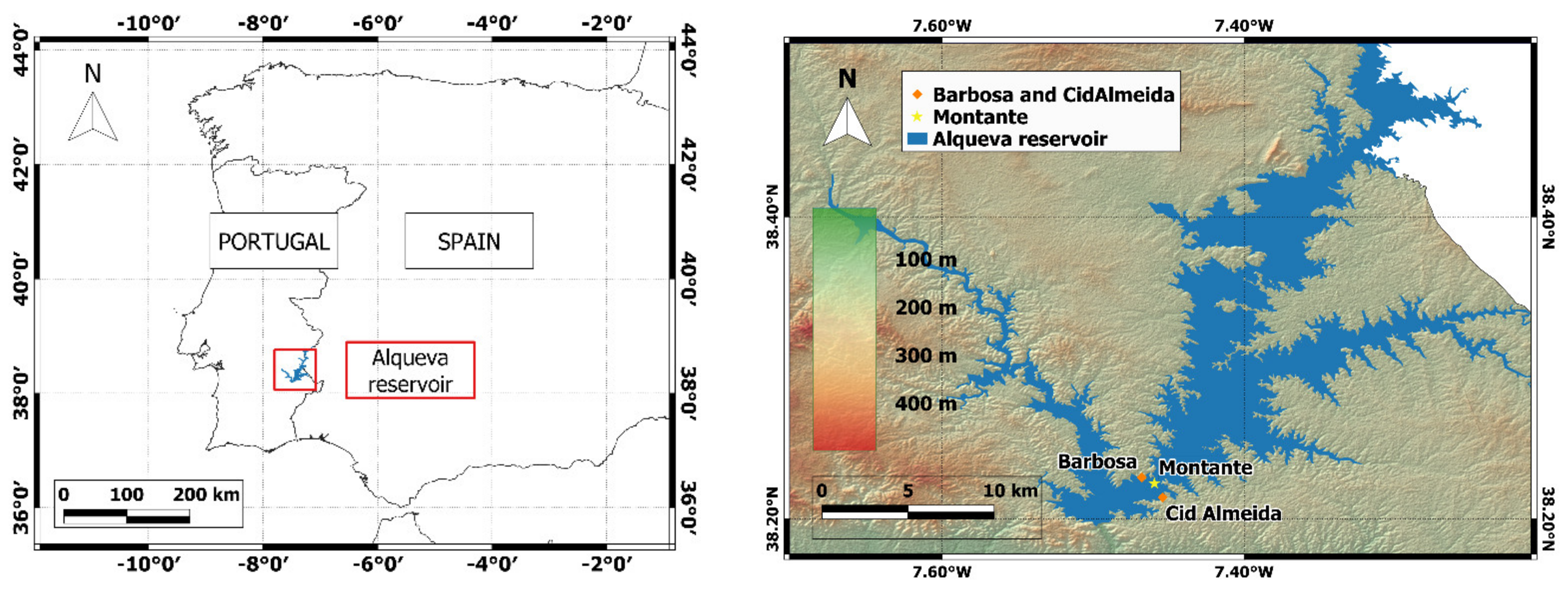
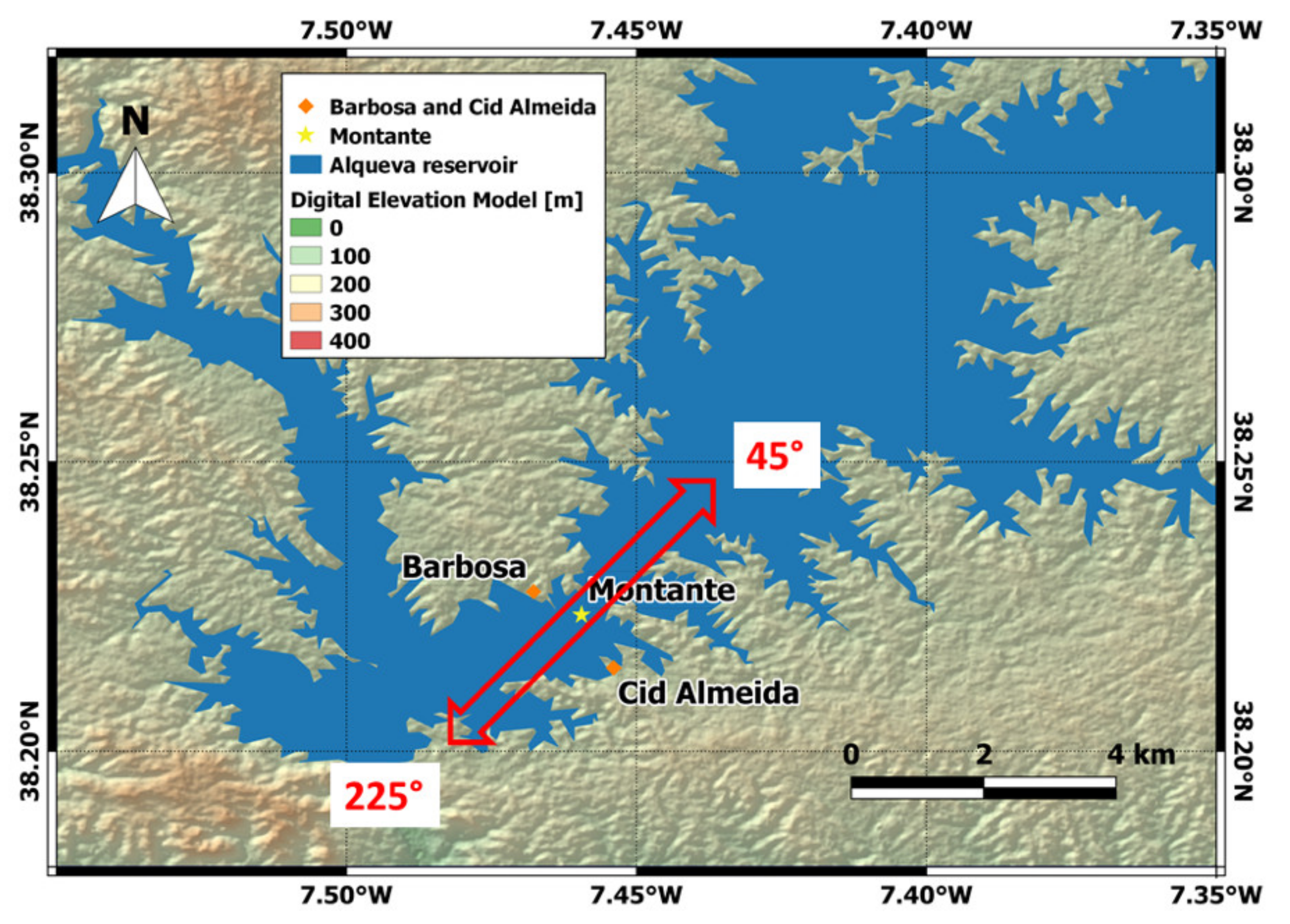
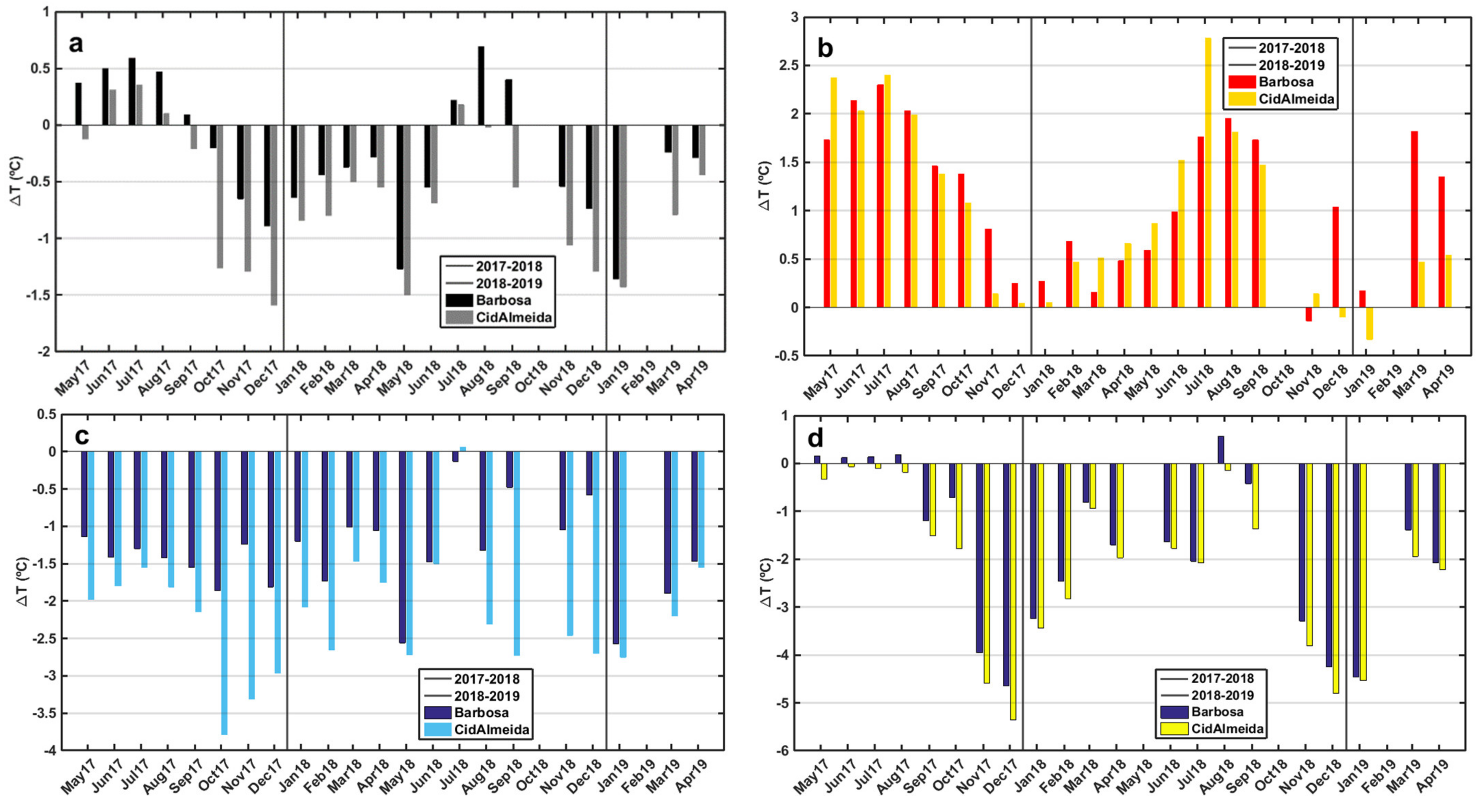
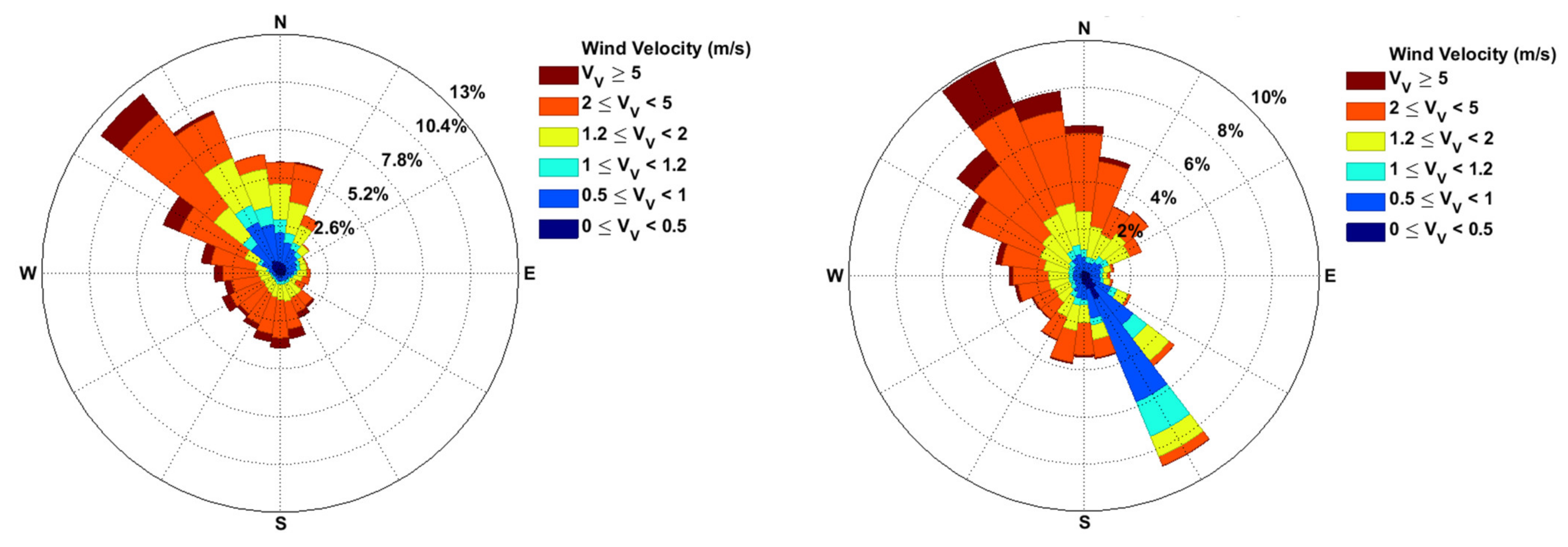
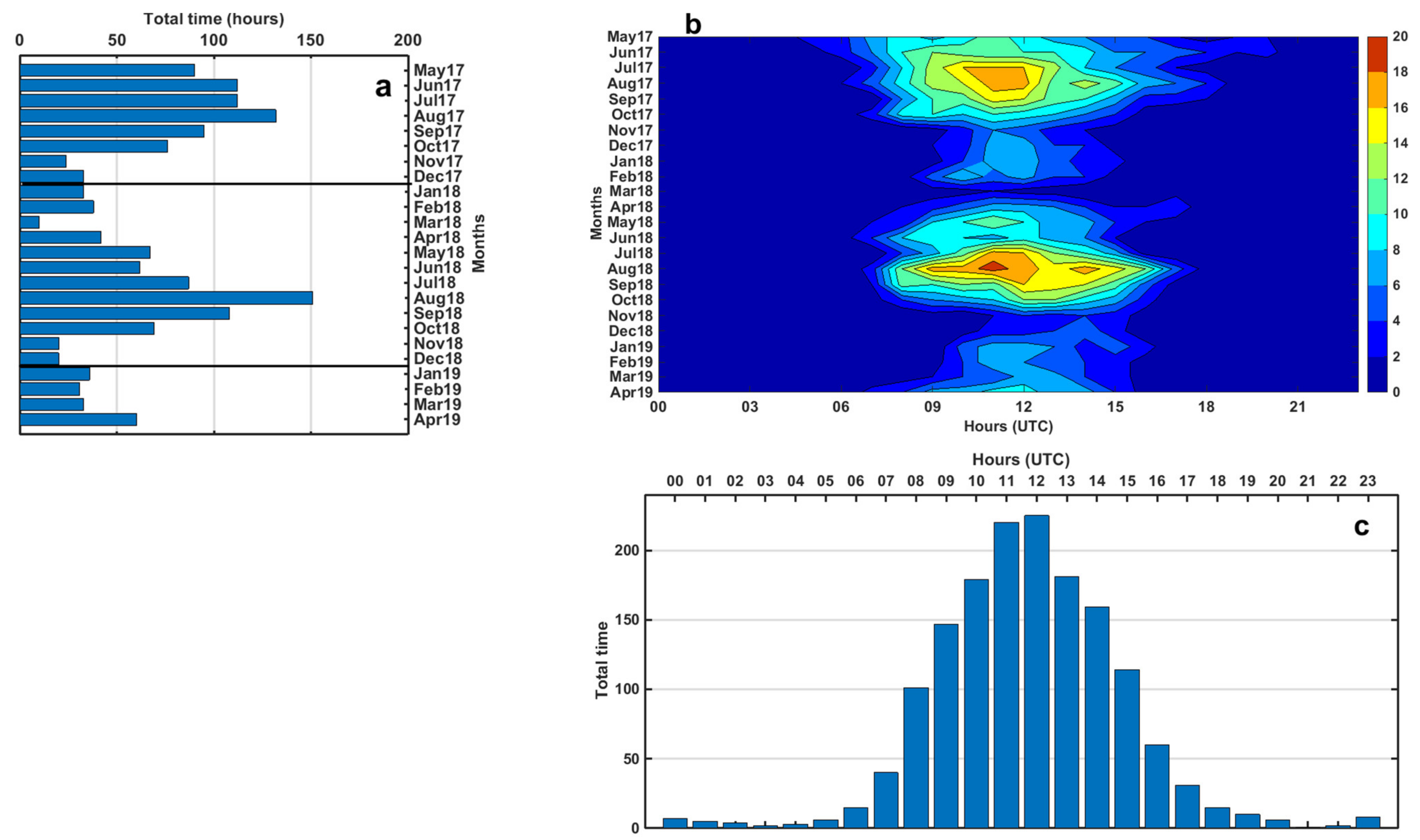

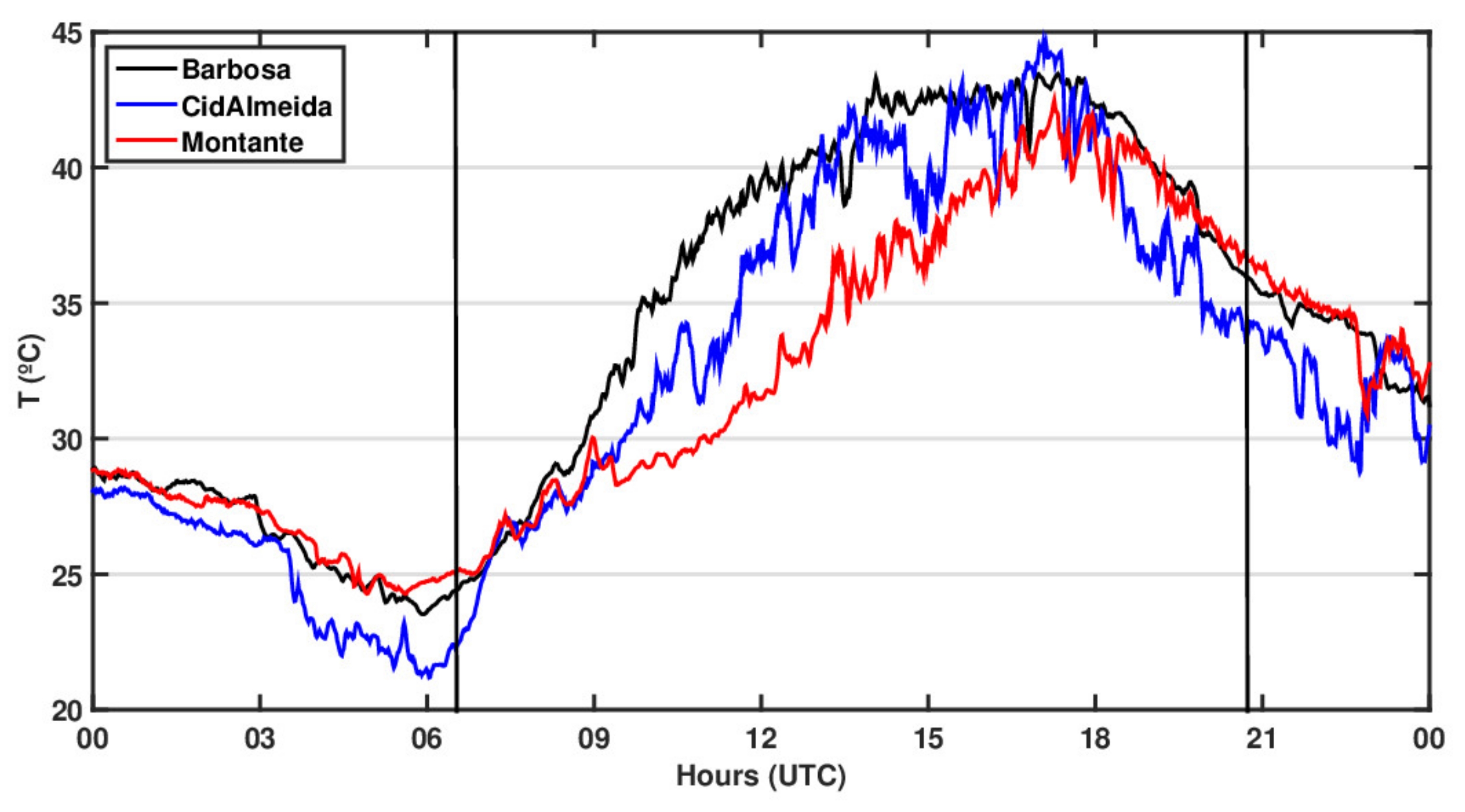

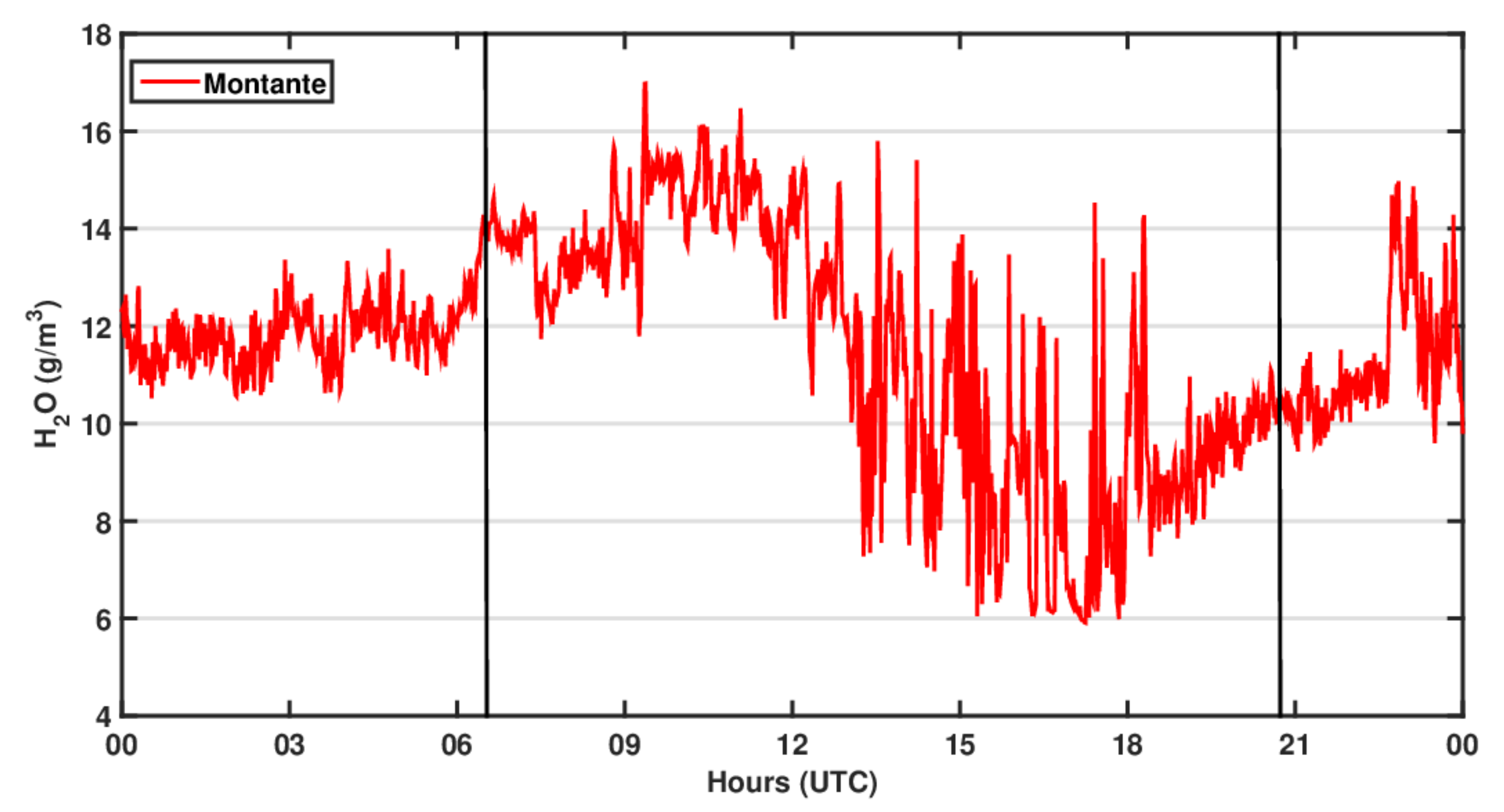
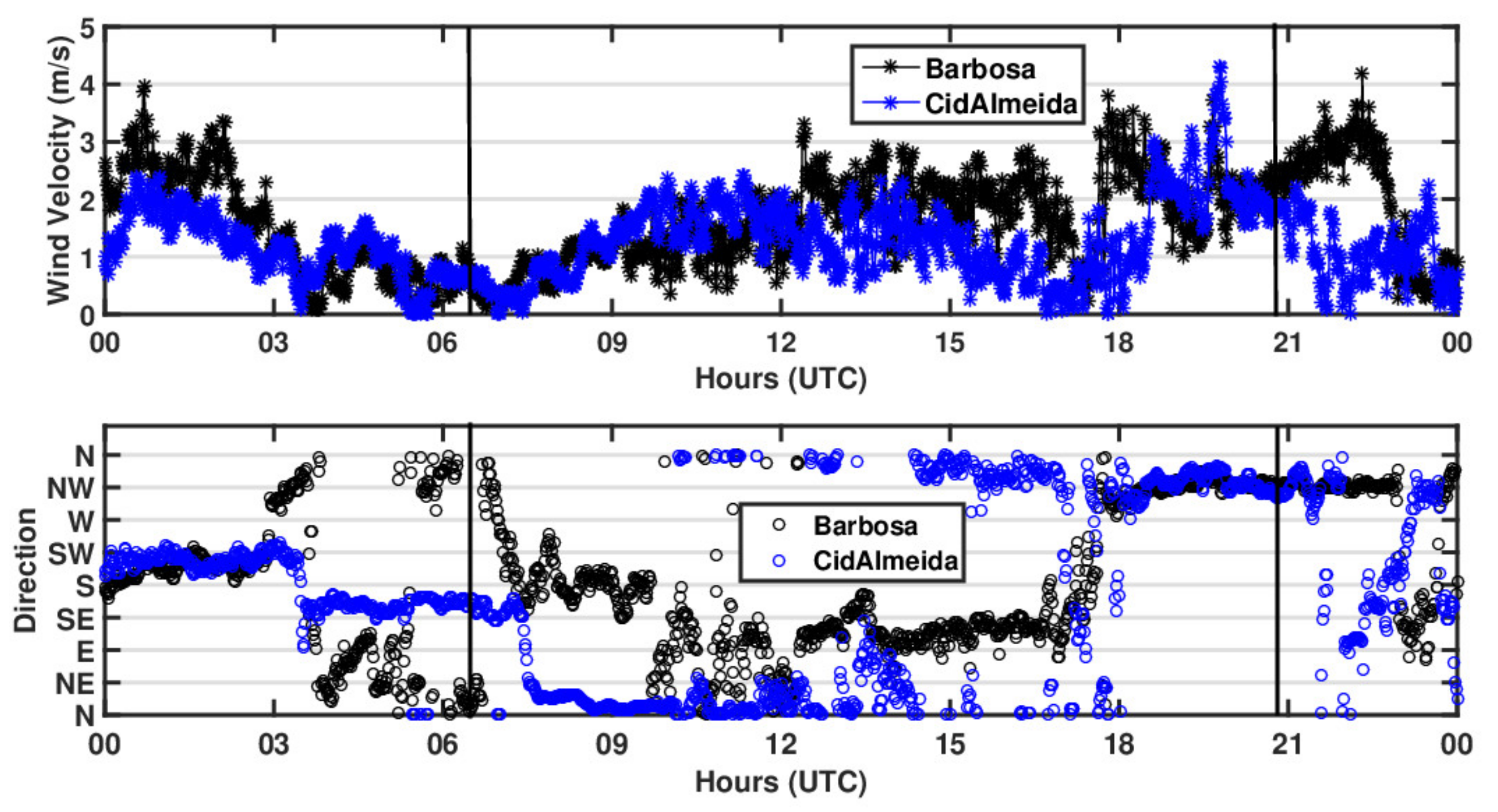
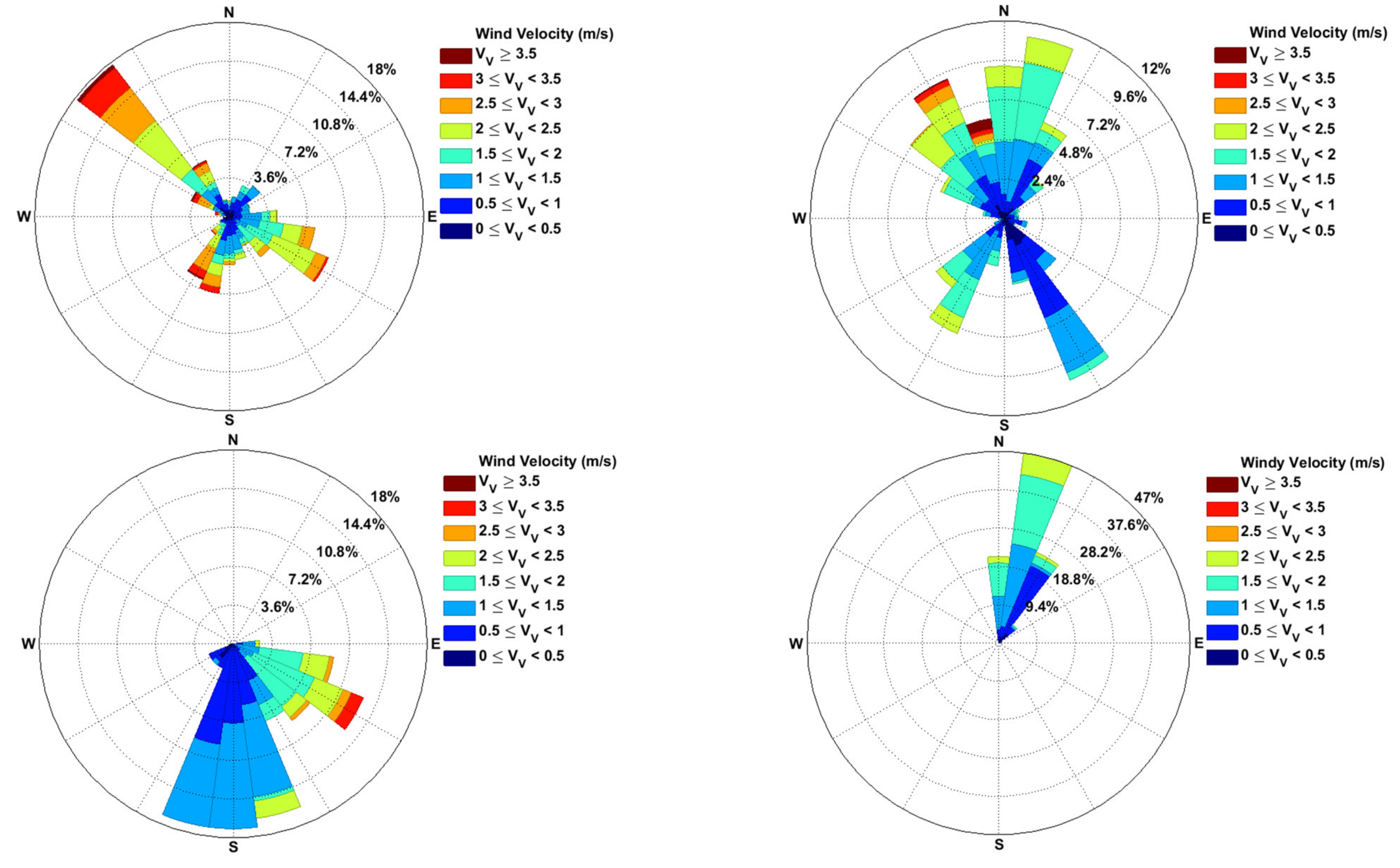
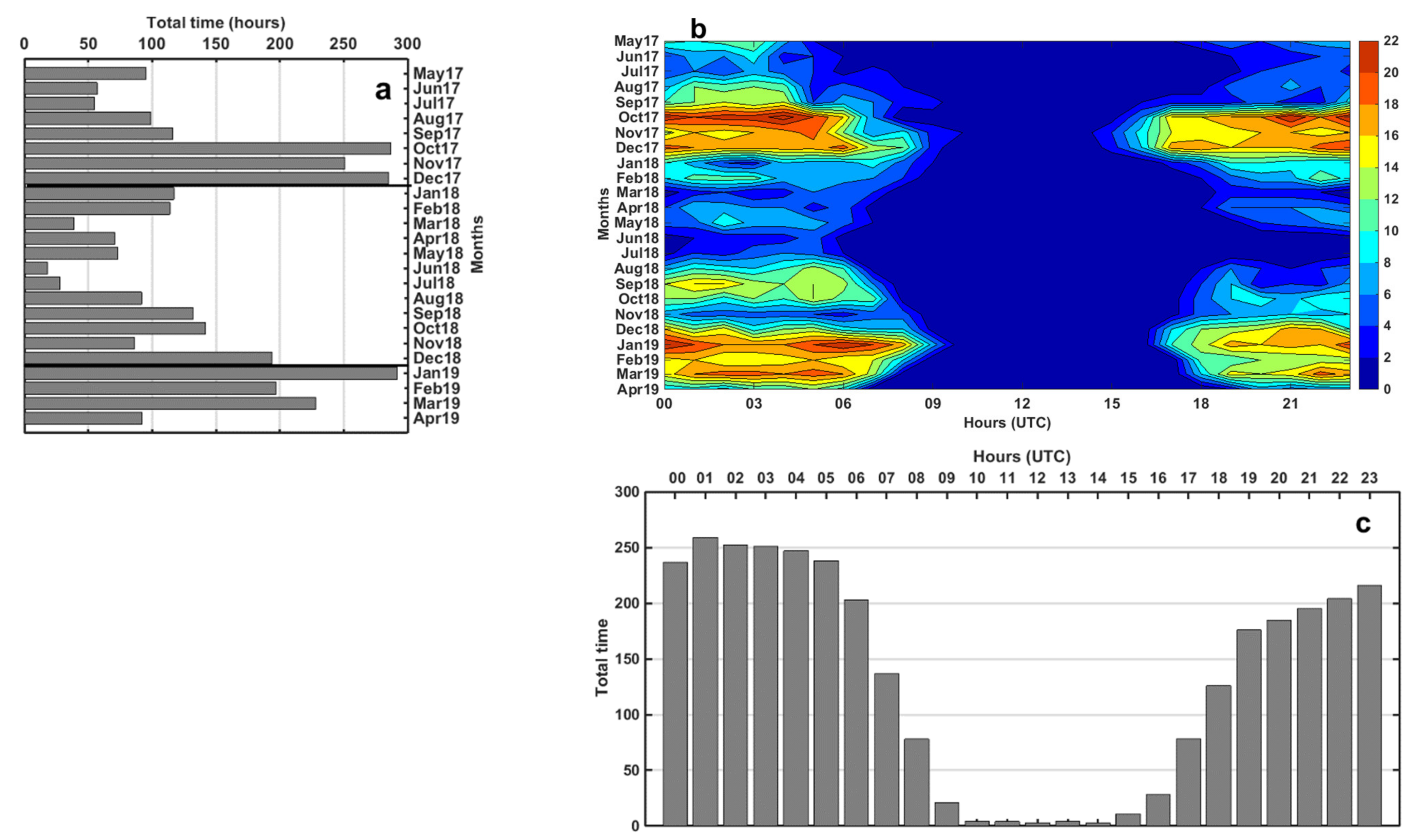
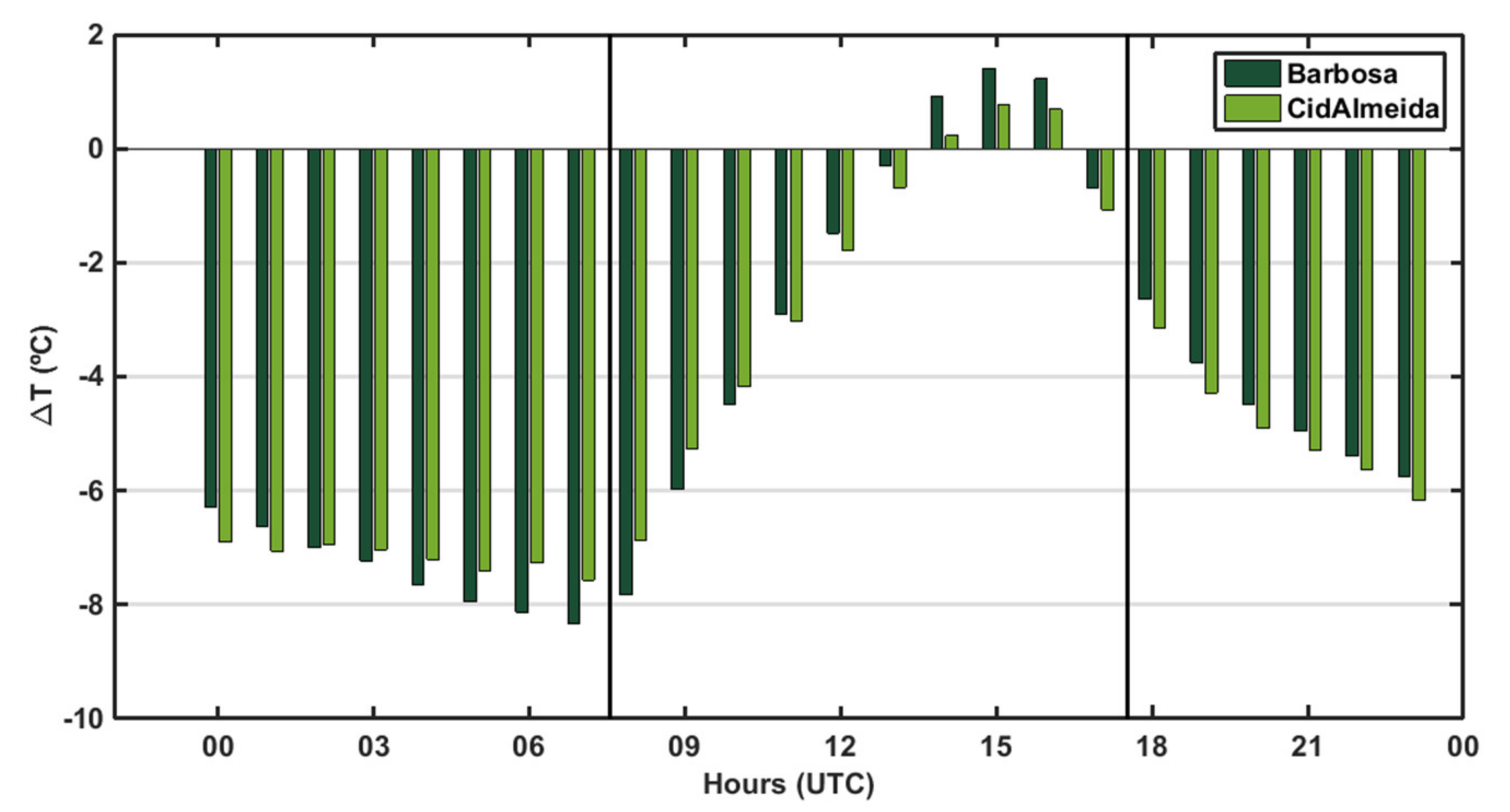

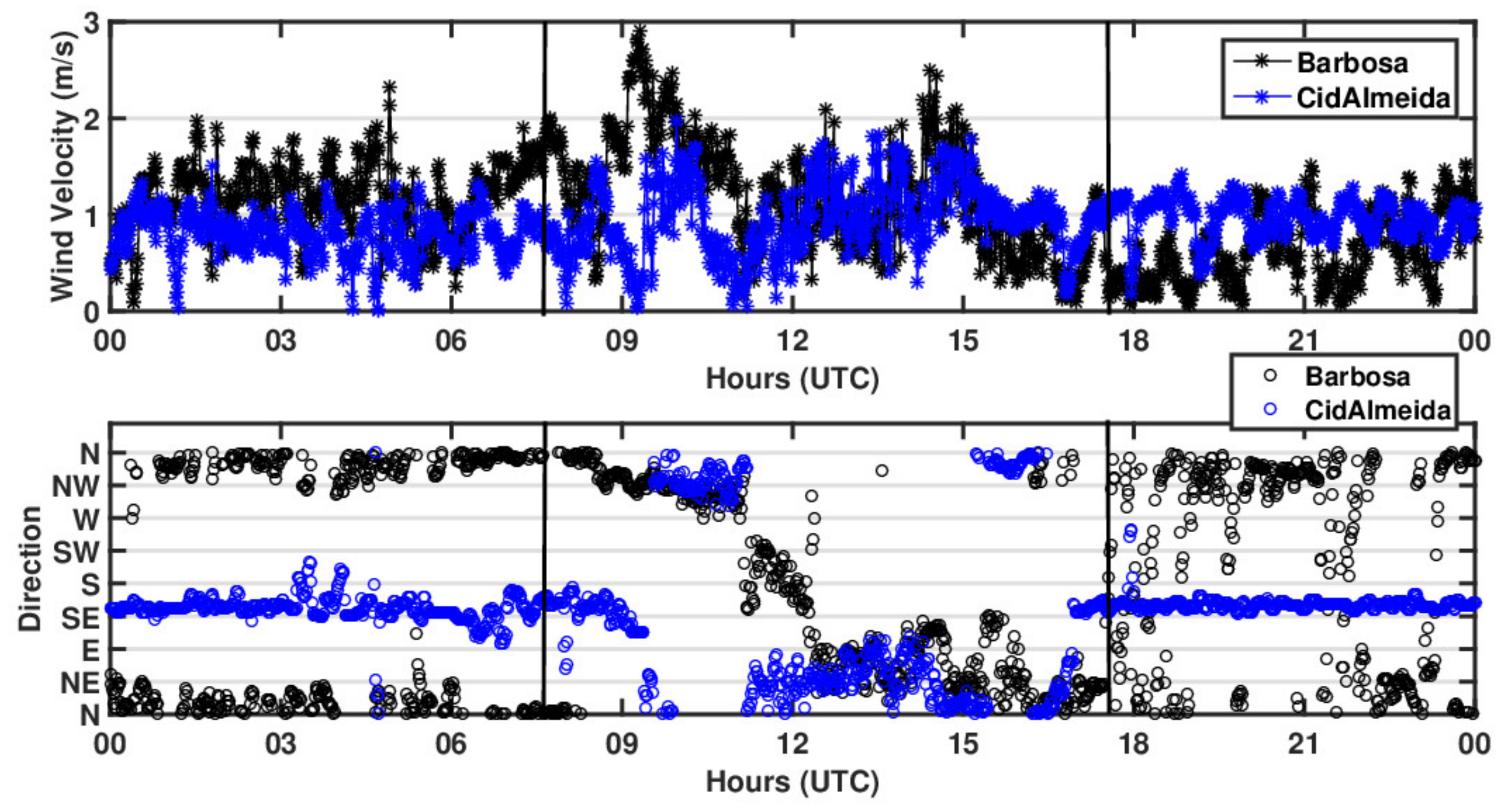
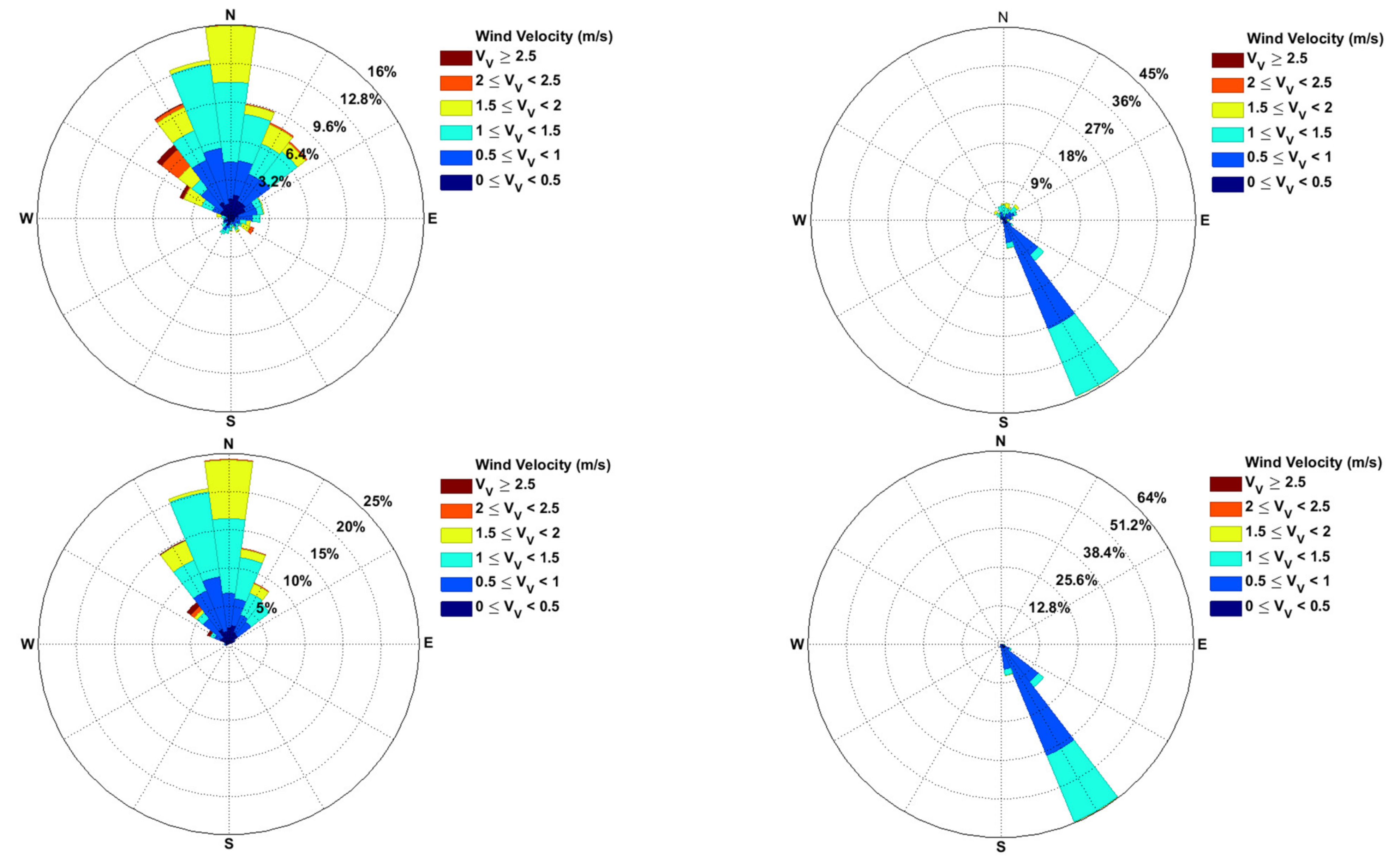
Publisher’s Note: MDPI stays neutral with regard to jurisdictional claims in published maps and institutional affiliations. |
© 2021 by the authors. Licensee MDPI, Basel, Switzerland. This article is an open access article distributed under the terms and conditions of the Creative Commons Attribution (CC BY) license (https://creativecommons.org/licenses/by/4.0/).
Share and Cite
Purificação, C.; Potes, M.; Rodrigues, G.; Salgado, R.; Costa, M.J. Lake and Land Breezes at a Mediterranean Artificial Lake: Observations in Alqueva Reservoir, Portugal. Atmosphere 2021, 12, 535. https://doi.org/10.3390/atmos12050535
Purificação C, Potes M, Rodrigues G, Salgado R, Costa MJ. Lake and Land Breezes at a Mediterranean Artificial Lake: Observations in Alqueva Reservoir, Portugal. Atmosphere. 2021; 12(5):535. https://doi.org/10.3390/atmos12050535
Chicago/Turabian StylePurificação, Carolina, Miguel Potes, Gonçalo Rodrigues, Rui Salgado, and Maria João Costa. 2021. "Lake and Land Breezes at a Mediterranean Artificial Lake: Observations in Alqueva Reservoir, Portugal" Atmosphere 12, no. 5: 535. https://doi.org/10.3390/atmos12050535
APA StylePurificação, C., Potes, M., Rodrigues, G., Salgado, R., & Costa, M. J. (2021). Lake and Land Breezes at a Mediterranean Artificial Lake: Observations in Alqueva Reservoir, Portugal. Atmosphere, 12(5), 535. https://doi.org/10.3390/atmos12050535








